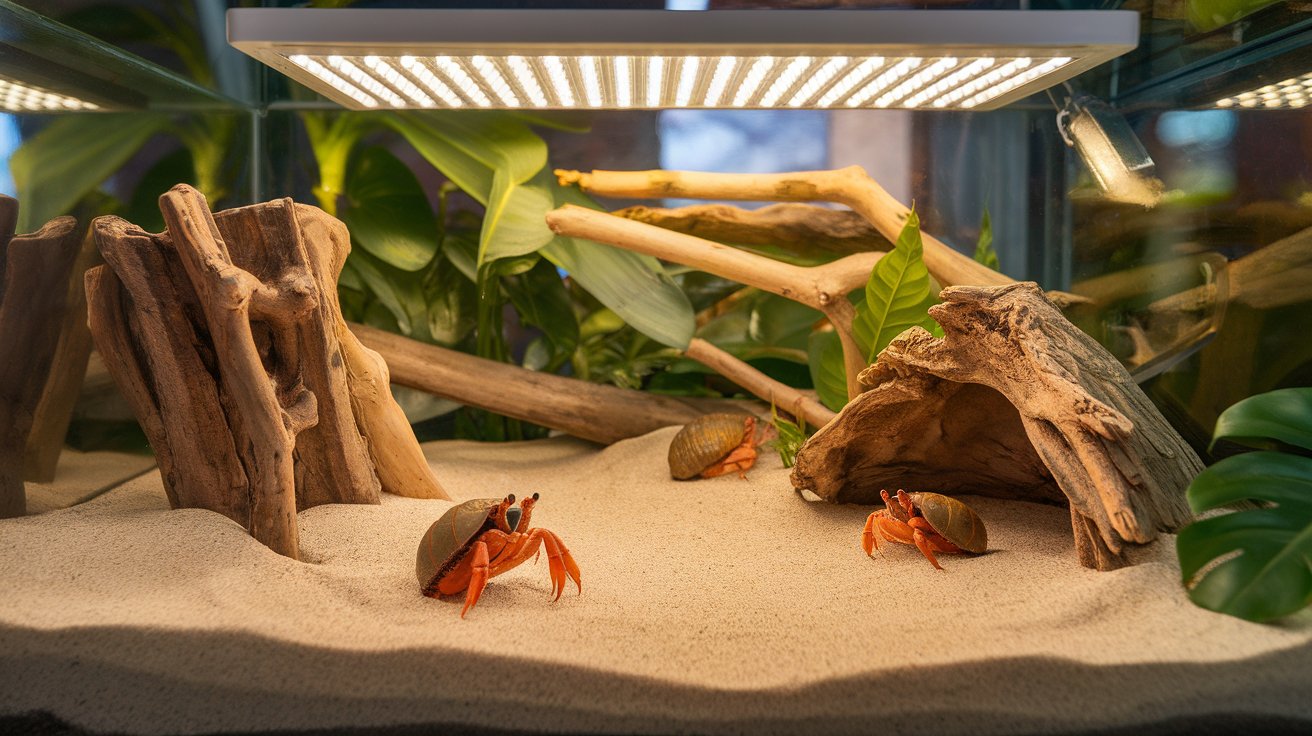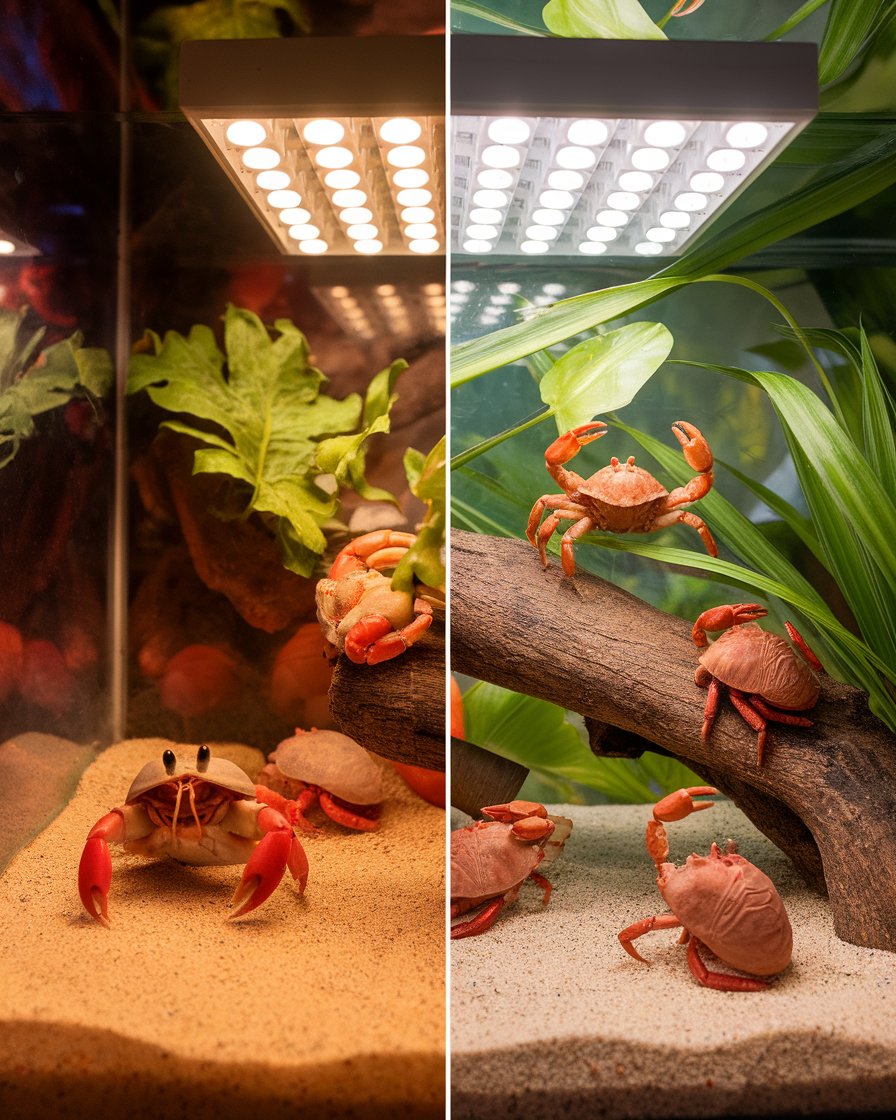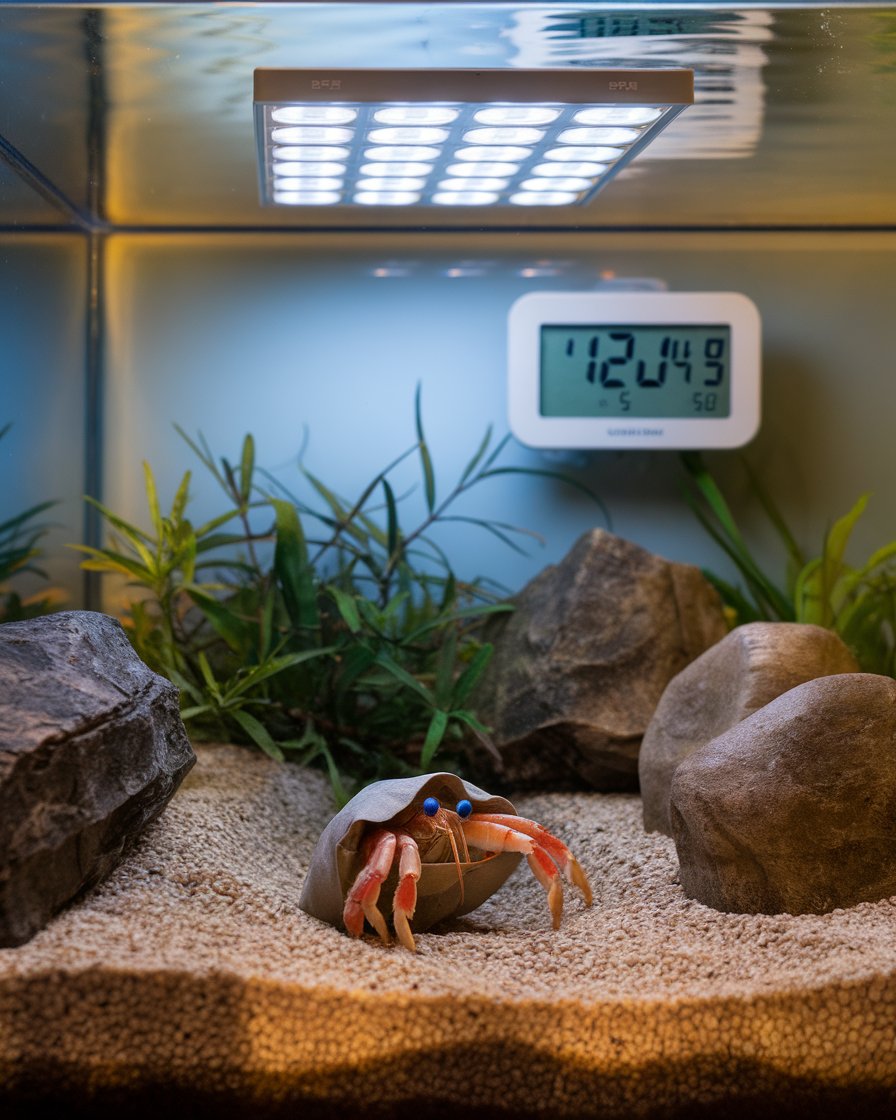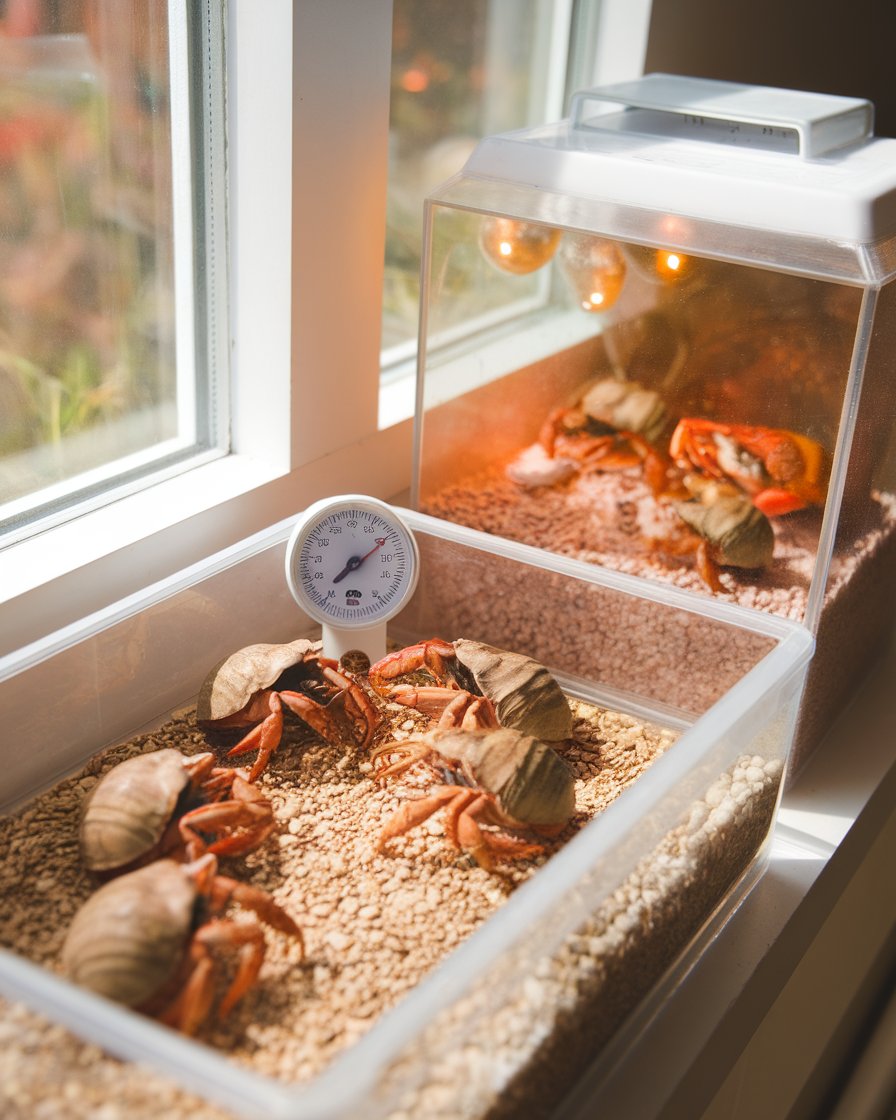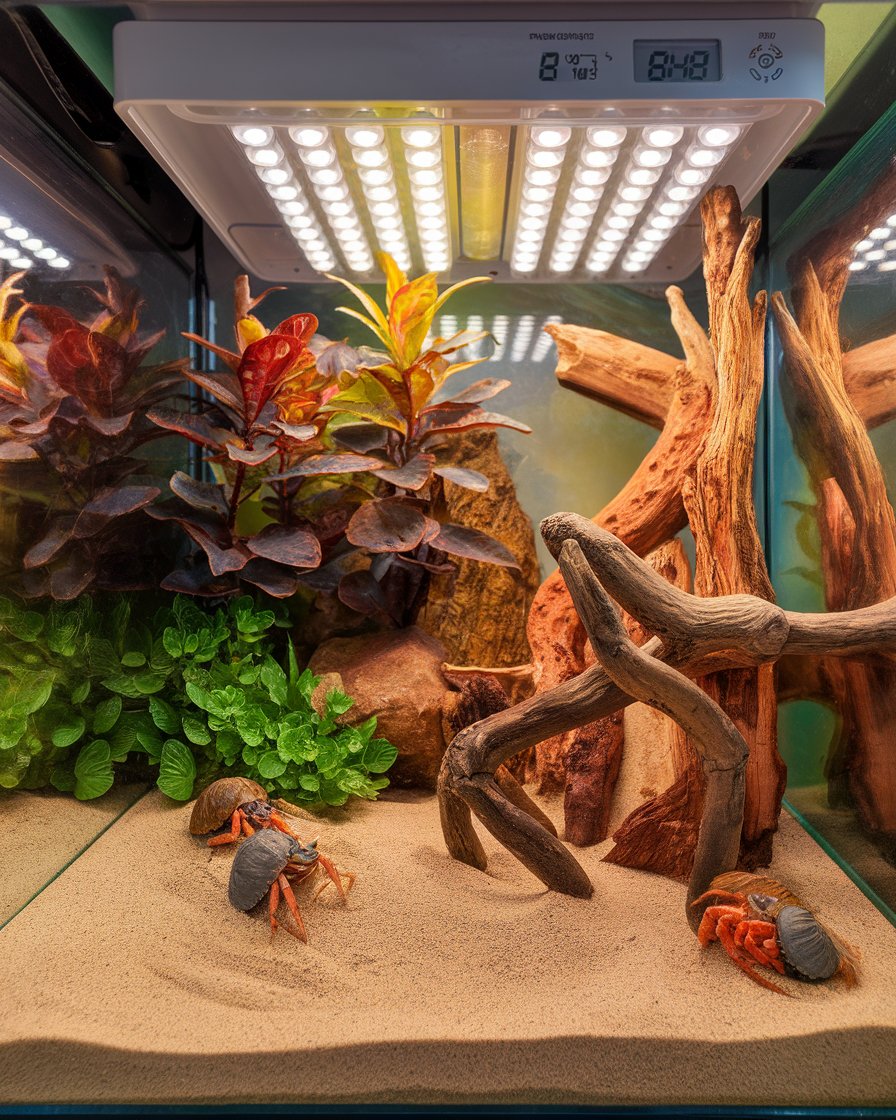Introduction
When it comes to caring for hermit crabs, creating the right lighting environment is crucial for their health and happiness. Hermit crabs need a balance of light and darkness to regulate their natural behaviors, such as foraging and burrowing. Proper lighting also supports their ability to absorb essential nutrients like vitamin D. While natural sunlight may not always be available, artificial lighting options can mimic these natural conditions. Full-spectrum bulbs, especially those that emit ultraviolet light, are often recommended for optimal hermit crab lighting and heating, ensuring your crabs thrive in their enclosure.
Many hermit crab owners wonder about the best lights safe for hermit crabs, and the answer lies in understanding their specific needs. Heat lamps or incandescent bulbs, used in combination with other lighting fixtures, can provide the warmth they require without overwhelming them. Hermit crabs are nocturnal creatures, so maintaining a consistent day/night cycle with the right fixtures helps support their natural rhythms. Whether you’re using a lamp in their aquarium or a more advanced lighting system, it’s important to provide lots of light during the day and maintain darkness at night to ensure your hermit crabs’ overall well-being.
Key Takeaways
-
Hermit crabs need a proper balance of light and darkness to regulate their natural behaviors, such as foraging and burrowing.
-
Full-spectrum bulbs, including UVB light, are recommended to mimic natural light conditions and support hermit crab health and vitality.
-
Artificial lighting options like halogen or LED bulbs are safer alternatives to natural sunlight, preventing overheating while maintaining a stable environment.
-
Heat lamps or incandescent bulbs, combined with other fixtures, help keep the enclosure warm and support a consistent day/night cycle.
-
Monitoring light exposure through timers ensures your crabs follow their natural rhythms, reducing stress and promoting healthy behaviors.
-
Understanding that hermit crabs don’t need direct sunlight allows owners to create a safe and comfortable habitat with artificial lighting solutions.
Hermit Crab Association’s Recommendations
The Hermit Crab Association (HCA) emphasizes the importance of providing a safe and comfortable environment for your hermit crabs. As these creatures are sensitive to their surroundings, proper lighting and heating are essential for maintaining their health and well-being. Hermit crabs thrive in habitats that mimic their natural environment, which includes a balanced light cycle and stable temperature. Without proper care, such as the right light and heat sources, hermit crabs can become stressed or even ill. Therefore, the HCA advises owners to carefully select appropriate lighting and heating options that best suit their crabs’ needs while ensuring the enclosure is a stable and safe home for them to flourish.
Key Lighting and Heating Tips for Hermit Crabs
1. Mimic Natural Light Cycles
Hermit crabs need a light and dark cycle that simulates their natural environment. A 12-hour light and 12-hour dark schedule helps regulate their circadian rhythms, promoting natural behaviors such as burrowing and foraging. This can be achieved using artificial lighting, such as LED lights or UVB bulbs, which mimic daylight without exposing the crabs to harmful direct sunlight.
2. Use Full-Spectrum Lighting for Health
To support calcium absorption and overall vitality, it’s beneficial to use full-spectrum lighting that includes UVB rays. This type of light helps your hermit crabs maintain healthy shells and enhances their color vibrancy. Full-spectrum LED lights are a safe and effective way to provide the necessary illumination without overheating the enclosure.
3. Heat Pads as a Safe Alternative
Instead of relying solely on heat lamps, which can sometimes emit too much heat or cause issues with humidity, consider using Under Tank Heat (UTH) pads. These pads offer gentle, consistent warmth to the substrate, maintaining a balanced temperature for your hermit crabs while preventing drastic temperature fluctuations.
4. Avoid Direct Sunlight Exposure
Contrary to popular belief, hermit crabs don’t need natural sunlight. Direct sunlight can overheat the tank and stress your crabs. Instead, use indirect artificial lighting, like fluorescent or halogen bulbs, to provide the necessary light and warmth while keeping the environment safe and controlled.
5. Monitor Humidity and Temperature
Maintaining the right balance of temperature and humidity is crucial for a hermit crab’s health. Use a humidifier or mist the tank regularly to ensure the environment stays moist. At the same time, keep an eye on temperature levels with tank heaters and adjust the lighting to maintain a stable habitat.
6. Balance Lighting with Habitat Needs
Hermit crabs need light to support their natural activities, but over-lighting can cause stress. Make sure your lighting fixtures are positioned correctly in the tank, and use a timer to regulate light exposure. Always ensure there are darker areas available where your crabs can burrow and escape from the light if needed.
Importance of Providing Light for Hermit Crabs
Providing the right light for your hermit crabs is vital for their overall health. In their natural habitats, hermit crabs are exposed to both daylight and darkness, which helps regulate their circadian rhythms. This day/night cycle is crucial for their behavior, digestion, and even their ability to absorb important nutrients like calcium. Using proper lighting, such as an LED light or a UVB bulb, helps mimic these conditions within the enclosure. Without enough light, hermit crabs can experience stress and behavioral issues. It’s important to create a balance of light and dark to promote healthy behavior and ensure your crabs live comfortably in their hermit crab tank.
Alternative Light Sources for Hermit Crabs
If you’re unsure about which lighting to use, the Hermit Crab Association suggests exploring alternative light sources, like Under Tank Heat (UTH) pads. These heat pads provide warmth without the need for a traditional heat bulb or lightbulb, which can sometimes emit too much heat or cause issues with humidity levels in the tank. UTH pads are particularly helpful because they offer a gentle, even warmth across the tank substrate, helping to maintain a safe and stable environment for your hermit crabs. While it’s best to provide some light, using these pads can be another option to ensure that your crabs stay warm without overheating or drying out.
Creating a Day/Night Cycle for Hermit Crabs
Hermit crabs thrive in environments that mimic their natural habitat, and one of the most important factors in maintaining their health is creating a proper day/night cycle. Replicating a consistent light schedule helps regulate their circadian rhythms, which in turn supports their overall well-being. In the wild, hermit crabs experience around 12 hours of light and 12 hours of darkness, which reduces stress and promotes natural behavior like burrowing and foraging. Whether you’re using an aquarium or another type of enclosure, establishing a reliable day/night cycle is key to keeping your hermit crabs healthy and happy. Consistency in lighting can prevent sudden changes that may lead to stress or illness in these sensitive creatures.
Case Study: Implementing a Day/Night Cycle for Hermit Crabs in Captivity
A hermit crab enthusiast, Sarah, set up an aquarium to mimic the natural environment of her hermit crabs. After reading recommendations from the Hermit Crab Association, she implemented a 12-hour light and 12-hour dark schedule using a combination of LED lights and full-spectrum bulbs. This setup helped replicate the day/night cycle that hermit crabs experience in the wild.
Within a few weeks, Sarah noticed her crabs becoming more active, engaging in natural behaviors like burrowing and climbing during the illuminated hours. Their shell colors became more vibrant due to proper exposure to UVB rays, which are essential for calcium absorption. Sarah also maintained consistent humidity levels, preventing any temperature fluctuations that could cause stress. This case highlights how a well-balanced light cycle, paired with the correct lighting sources, can improve the overall well-being of hermit crabs in captivity.
Maintaining a Natural Light Cycle
Maintaining a natural light cycle for your hermit crabs involves simulating the consistent patterns they would experience in the wild. A 12-hour light and 12-hour dark schedule works well to keep them in sync with their circadian rhythms. While hermit crabs don’t necessarily need bright light, providing a steady source of light during the day helps them understand when it’s time to be active. Avoiding harsh or sudden changes in lighting is crucial, as these can cause stress. Using soft, indirect light from an incandescent or fluorescent lamp can be an effective way to create a gentle day/night cycle without overwhelming their environment. This also helps regulate the temperature and promotes natural behaviors like burrowing.
Simulating Daylight for Hermit Crabs
To simulate daylight effectively for your hermit crabs, full-spectrum lighting is recommended. This includes using light sources that emit UVB rays, which can aid in their calcium absorption and overall vitality. Specialized reptile lamps designed for UV light are an ideal solution as they provide the necessary light spectrum without overheating the enclosure. While hermit crabs do not need direct sunlight, replicating daylight through UV light can encourage healthy activity and support their growth. Be mindful of the placement of these lights, ensuring they are not too close to the crabs to avoid excessive heat. Maintaining proper lighting, along with the right humidity levels, creates an optimal environment where hermit crabs can thrive.
Common Misconceptions About Hermit Crab Lighting
There are several misconceptions about the lighting needs of hermit crabs that can lead to confusion for pet owners. One of the most common misunderstandings is the belief that hermit crabs require direct natural sunlight to thrive. While hermit crabs do need a regulated day/night cycle, direct sunlight can actually be harmful. Instead, artificial lighting that mimics a 12-hour light and 12-hour dark cycle works just as well for their health. Proper lighting, when combined with correct humidity and temperature levels, ensures that your hermit crabs remain active and healthy. It’s important to understand these lighting myths to create a safe and comfortable habitat for your crabs.
Myth: Natural Sunlight is Necessary
One persistent myth is that hermit crabs must have access to natural sunlight to stay healthy. While a consistent day/night cycle is essential, direct sunlight is not. In fact, exposing your hermit crabs to too much natural sunlight can raise the temperature in their tank to dangerous levels. Artificial lighting, such as halogen or LED bulbs, can provide the necessary light without the risks associated with direct sunlight. These options allow you to safely replicate a natural light cycle while maintaining control over the temperature and humidity in the enclosure. Understanding that hermit crabs don’t need natural sunlight helps you avoid common mistakes and keeps them comfortable.
Debunking Misinformation on Hermit Crab Lighting
Misinformation surrounding hermit crab lighting often leads to unnecessary complications. Many new hermit crab owners assume that specific, complex lighting systems are required for their crabs to thrive. In reality, simple light bulbs that provide a balanced day/night rhythm are enough to support their health. Specialized lamps, such as those offering full-spectrum light with UVB rays, can further enhance their well-being by supporting their vitamin D absorption and coloration. Ensuring proper light, heat, and humidity in the tank is key to creating an optimal habitat. With the right setup, you’ll see your crabs remain active, healthy, and vibrant year-round, without the need for natural sunlight.
“Knowledge without love will not stick. But if love comes first, knowledge is sure to follow.” – John Burroughs
Setting Up the Ideal Lighting
Creating the perfect lighting environment for hermit crabs is essential for their health and well-being. Hermit crabs rely on a consistent light cycle to regulate their behavior and circadian rhythms, similar to what they would experience in the wild. Proper lighting ensures they remain active, maintain vibrant colors, and absorb necessary nutrients like vitamin D. Setting up the right lighting solution in your hermit crab enclosure not only supports their physical health but also promotes natural behaviors like foraging and burrowing. With the correct balance of light and dark, your crabs can thrive, offering a lively and engaging pet experience.
Choosing the Right Light Bulbs
When it comes to choosing the right light bulbs for your hermit crab’s enclosure, any standard light that mimics natural sunlight will do. However, for better results, owners may want to consider full-spectrum bulbs that include UVB rays. These bulbs not only help mimic the natural day/night cycle but also enhance your crabs’ activity levels and color vibrancy. UVB rays can aid in vitamin D synthesis, supporting their overall health. Whether you opt for incandescent or LED bulbs, it’s important to consider your crabs’ specific lighting needs. By choosing the right light options for hermit crabs, you can create a more comfortable and enriching environment for them.
Monitoring Light Exposure for Hermit Crabs
Maintaining a consistent day/night cycle is key to keeping your hermit crabs stress-free and healthy. The ideal setup involves roughly 12 hours of light and 12 hours of darkness, allowing crabs to follow their natural rhythms. Timers can help manage the lighting schedule, ensuring your hermit crabs get the right balance of light without any sudden changes. Too much exposure to bright white light or inadequate darkness can disrupt their behaviors and cause stress. Monitoring the lighting closely and making adjustments based on your habitat’s needs will keep your crabs happy and allow them to behave naturally, like burrowing or climbing, in their aquarium setup.
Conclusion
To keep your hermit crabs healthy and happy, it’s important to create the right lighting and heating setup. While hermit crabs need a light source, they don’t require access to natural light. Instead, artificial lighting like LED or UVB bulbs can recreate their natural environment just fine. These bulbs also help maintain the right temperature, and when paired with heat mats, you can keep the enclosure warm enough without messing up the humidity.
Keeping a consistent day/night cycle is also key. Setting your lights on a timer to provide about 12 hours of light and 12 hours of darkness helps the crabs follow their natural rhythms. Plus, using proper lighting, like tank heaters or LED bulbs, ensures they aren’t exposed to too much light or heat. Remember to always keep an eye on the setup to avoid issues. Following these simple steps will ensure your hermit crabs have a safe, comfy, and stress-free home.

